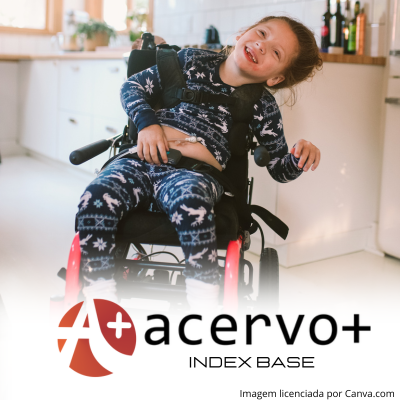Principais músculos acometidos em pacientes pediátricos com paralisia cerebral tratados em um hospital de referência na Amazônia brasileira
##plugins.themes.bootstrap3.article.main##
Resumo
Objetivo: Analisar os músculos mais acometidos em pacientes pediátricos com paralisia cerebral espástica, além de traçar o perfil clínico-epidemiológico e avaliar a função motora e funcional desses indivíduos. Métodos: O estudo foi de caráter observacional, prospectivo, transversal, descritivo, analítico e unicêntrico, com enfoque quantitativo e qualitativo, na investigação da relação entre o perfil clínico, histórico pessoal pregresso e, principalmente, o grau de espasticidade muscular. Resultados: A amostra era predominantemente composta por meninos (58,4%) com idade média de 8 anos. A maioria dos pacientes procedia da Região Metropolitana de Belém. Os músculos mais acometidos foram os gastrocnêmios e os isquiotibiais, com a espasticidade classificada principalmente no grau II da Escala de Ashworth, nível I na classificação de MACS e nível II na escala de GMFCS. Além disso, quanto ao tônus, a PC espástica foi a mais prevalente, representando 95% dos casos. Conclusão: As classificações usadas, como ASHWORTH, MACS e GMFCS, são ferramentas essenciais, mas têm limitações que podem influenciar a precisão dos resultados. Observou-se que os músculos mais acometidos, na amostra como um todo, foram os músculos gastrocnêmios, seguidos pelos isquiotibiais.
##plugins.themes.bootstrap3.article.details##
Copyright © | Todos os direitos reservados.
A revista detém os direitos autorais exclusivos de publicação deste artigo nos termos da lei 9610/98.
Reprodução parcial
É livre o uso de partes do texto, figuras e questionário do artigo, sendo obrigatória a citação dos autores e revista.
Reprodução total
É expressamente proibida, devendo ser autorizada pela revista.
Referências
2. ARCHANA K, et al. The profile of epilepsy and its characteristics in children with cerebral palsy. Seizure. 2022;101:190-6.
3. ARTHUSO CB. Quality of life in individuals with cerebral palsy: association with functional level and socio-demographic aspects. 2014.
4. AUBERT AM, et al. Risk factors for cerebral palsy and movement difficulties in 5-year-old children born extremely preterm. Pediatr Res. 2023.
5. BAR-ON L, et al. Spasticity and its contribution to hypertonia in cerebral palsy. Biomed Res Int. 2015;2015:1-10.
6. BECKUNG E, et al. The natural history of gross motor development in children with cerebral palsy aged 1 to 15 years. Dev Med Child Neurol. 2007;49:751-6.
7. BINHA AMP, et al. Epidemiological profile of patients with cerebral palsy treated at AACD - São Paulo. Acta Fisiátr. 2018;25(1):1-6.
8. CARVALHO IJS de A, et al. Informal caregivers of children with cerebral palsy: ways of coping with the uncertainty of illness. Rev Esc Enferm USP. 2023;57.
9. CHAGAS P, et al. Motor function classification and functional performance of children with cerebral palsy. Rev Bras Fisioter. 2008;12(5):409-16.
10. CHAGAS PSC, et al. Hamstring length, gross motor function, and gait in children and adolescents with cerebral palsy. Fisioter Pesqui. 2019;26(4):366-72.
11. COUBE M, et al. Inequalities in unmet need for healthcare services and medications in Brazil: a decomposition analysis. Lancet Reg Health Am. 2023;19:100426.
12. DE MELLO SPOSITO MM, RIBERTO M. Functionality assessment of children with spastic cerebral palsy. Acta Fisiátr. 2010;17(2):50-61.
13. ESTELLES JRD, et al. Equinus foot in children with cerebral palsy: treatment. Projeto Diretrizes: Associação Médica Brasileira. 2013.
14. FARO MG, et al. Influence of motor severity on self-care performance in children and adolescents with cerebral palsy. Rev Chil Ter Ocup. 2022;21(1):141-52.
15. KEREM M, et al. Effects of Johnstone pressure splints combined with neurodevelopmental therapy on spasticity and cutaneous sensory inputs in spastic cerebral palsy. Dev Med Child Neurol. 2001;43(5):307-13.
16. KLEINER AF, et al. Functional mobility in individuals with spastic cerebral palsy according to type and age. Rev Port Ciênc Desporto. 2008;8(3).
17. MOURA AMB. Correlation between modified Ashworth, modified Tardieu, and visual analog scales in individuals with spinal cord injury. Departamento de Fisioterapia, Rio Grande do Norte. 2023.
18. MÜLLER A, VALENTINI N. Kinesiological analysis of equinovarus foot in children with spastic cerebral palsy. Rev Bras Ciênc Saúde. 2016;20(3):253-8.
19. Petry IL, et al. Experiences of caregivers of children with cerebral palsy regarding gastrostomy use. Rev Enferm Atenção Saúde. 2023;12(3).
20. PFEIFER LI, et al. Classification of cerebral palsy: association between gender, age, motor type, topography, and gross motor function. Arq Neuropsiquiatr. 2009;67(4):1057-61.
21. SANTOS NSC, et al. Epidemiological profile of patients with cerebral palsy treated at the physical therapy clinic of São Judas Tadeu University. Rev Bras Ciênc Bioméd. 2021;2:1-7.
22. SILVA SG, et al. Incidence of children born with cerebral palsy and physical therapy interventions. Rev Cient Rumos Inf. 2022;3(1):66-87.
23. TEIXEIRA AJX. Effects of botulinum toxin on spasticity and upper limb functionality in children with cerebral palsy: an integrative literature review [dissertation]. Goiânia: Pontifícia Universidade Católica de Goiás; 2024.
24. TELES MS, MELLO EMCL. Botulinum toxin and physical therapy in children with spastic cerebral palsy: a literature review. Fisioter Mov. 2011;24(1):181-90.
25. TOLEDO CAW de, et al. Health profile of children diagnosed with cerebral palsy treated at the Lucy Montoro Rehabilitation Center in São José dos Campos. Acta Fisiátr. 2015;22(3).

